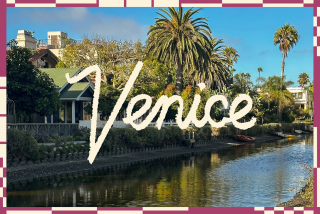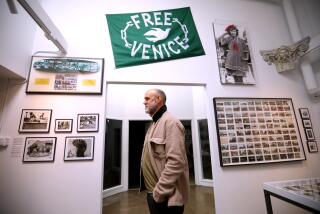Traveling in Italy on a Slow Boat to Venice
- Share via
VENICE, Italy — There is nothing unusual about approaching this city by water. Almost every visitor does. But arriving at the “Pearl of the Adriatic” via the Brenta Canal can provide both the perfect end to a delightful day and an extraordinary introduction to one of the world’s most fascinating cities.
Reaching Venice is indeed a bonus, the final lap of a daylong excursion originating in the bustling city of Padua.
The trip is accomplished aboard Il Burchiello, the modern version of a 17th-Century vessel that was rowed and towed more than 20 miles along the picturesque waterway separating Padua and Venice.
The powered boat contains bar and bathroom and seats 70 passengers, most of them comfortably in a windowed cabin, a few alfresco in portable, unpadded plastic chairs.
The trip, which operates between April and October, can be made in either direction: Il Burchiello leaves Padua on Sundays, Wednesdays and Fridays and Venice on Tuesdays, Thursdays and Saturdays.
The fare of 90,000 lire (about $75 U.S.) includes a bus ticket back to the departure point, a lunch and the services of a multilingual guide.
Magnificent Villas
It also includes entrance fees to three magnificent villas that are visited en route. While most passengers went round trip, some took their luggage along (no extra charge) and used the tour as an innovative way to reach Venice.
Traveling on the Brenta is like boating on a meandering river, although the resemblance is interrupted periodically by locks that on the Padua-to-Venice route deposit the boat gently at a lower level.
The guide spoke over a semi-audible, public-address system in Italian, French, German and English. She said the locks were invented by Leonardo da Vinci, but it was not clear whether she was talking about the Brenta locks or all locks.
The journey occasionally slowed while a variety of ingeniously designed bridges were swung, raised or drawn to permit Il Burchiello’s passage.
Nature’s Backdrop
These mechanical contrivances provided an interesting counterpoint as the boat cruised slowly through lush meadows, ripe vineyards, silvery-green olive orchards and fields bright with yellow sunflowers.
Although cars frequently passed noisily on a highway close to the canal, our sense of serenity returned quickly with a glimpse of a primitive farmhouse, a herd of goats or friendly waves from solitary fishermen along the grassy banks.
But the primary object of the trip is to visit the villas, extravagant examples of architectural splendor from the 17th and 18th centuries and which were suburban retreats for Venetian and Paduan nobility.
First stop on the eastward trip, reached after about an hour, was Villa Nazionale (also called Villa Pisani), a legendary estate once occupied for one night by Napoleon, and was the retrospectively infamous site of the first meeting between Adolf Hitler and Benito Mussolini.
Sumptuous Showplace
With its vast grounds, ponds, fountains, gardens, statuary and stables, the huge mansion could easily qualify as one of the most sumptuous showplaces on Long Island’s Gold Coast.
The outside beauty and grandeur was matched by the interior, a lavish collection of magnificently decorated rooms that provided an extraordinary look into another time and place.
The builder apparently had unlimited resources to baroque artists such as Tiepolo, whose “Apotheosis of the Pisani Family” decorated one of the rooms.
Striking murals and stunning ceilings were well maintained. One had little difficulty imagining Napoleon retiring imperially to his canopied bed in his ornately chandeliered bedroom.
The interior has resisted the passing of time better than several of the outbuildings, which could use some sprucing up. Deception plays a significant role both inside and out, with trompe l’oeil , a maze and an impressive facade that conceals stables.
‘No Reserved Seats’
As the cruise resumed, Il Burchiello sluiced through the green water. The guide resumed her multilingual litany. Other villas popped into view around bends in the canal, through hedges, behind stone fences and wrought-iron gates.
At Mira Porte we stopped to visit a 16th-Century villa that has been restored by an art professor named Tiozzo, who occupies it with his family. The frescoes he restored, once hidden by lime and grime, look as if they had just been painted.
Contemporary furniture blends with Renaissance walls and ceilings to create a timeless sense of beauty.
Tours of the two villas and the boat ride have stimulated appetites that were appeased in a bright and airy waterside restaurant called, appropriately, Il Burchiello.
Tiny freshwater clams, other seafood and unlimited bottles of local wine refreshed and fortified us for the remainder of the trip.
Isolation in Style
After lunch the pleasant journey continued at a relaxed pace, and our guide prepared us for an encounter with Andrea Palladio, the dean of Italian Renaissance architecture who designed Villa Malcontenta. The provocative name derived from its being built on a remote site to isolate a lady of the wealthy Foscari family, who was “malcontent” with her lot.
Its elegant style has attracted royalty since 1560; King Henry III, Ferdinand II and Queen Elizabeth II stayed there.
Late afternoon descended when Il Burchiello departed Malcontenta for Venice. As the boat left the mainland at Fusina and passed the pollution and industrial waste that poured out of the port and refinery city of Mestre, and as the smoke and smog and workaday world receded, ahead lay the exotic skyline of Venice: the Campanile, the dome of Santa Maria della Saute, the Basilica San Marco.
Suddenly it was sunset. The scene lasted for 10 or 15 minutes as the crimson sun burned through the haze and illuminated the low clouds with streaks of pink and purple.
And then Il Burchiello headed for its pier near the world-famous Piazza San Marco, the soul of this fairy-tale city of palaces and canals. As we crossed the mouth of the fabled Grand Canal we were surrounded by boats: tankers, yachts, ferries, gondolas, kayaks, vaporetti.
-- -- --
In Padua the Plaza at Corso Milano 40, with double, bath and breakfasts, costs $125 U.S. a night. Leon Bianco, Piazzetta Pedrocchi 12, double with bath and breakfast, is $70.
Notable restaurants: El Toula, Via Velle Parti 11. Dinner for two with wine is $55. Il Michelangelo, Corso Milan 22, is moderate, with dinner for two plus wine costing $45.
Stocco, Via dei Colli 164, is inexpensive. Dinner for two with wine is $25.
For more information on travel to Italy, contact the Italian Government Travel Office, 360 Post St., Suite 801, San Francisco, Calif. 94108, (415) 392-6206.
More to Read
Sign up for The Wild
We’ll help you find the best places to hike, bike and run, as well as the perfect silent spots for meditation and yoga.
You may occasionally receive promotional content from the Los Angeles Times.






